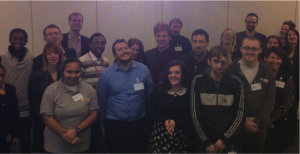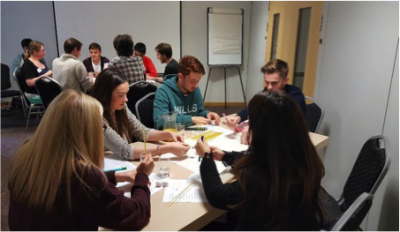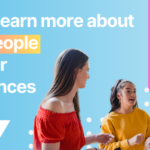Co-creation
Co-creation is the act of bringing different parties working together in order to produce an outcome which is jointly valued. Co-creation can happen in many instances for example with a company and its customers, a local council and its residents or senior management and employees.
When any product or service is created, it is essential to have all the users/influencers involved in the design of that product or service. A printable version of this document is available at the end of this page.
By working together in this way there is a greater opportunity to create something that can have a real impact for everyone involved.
This could not be more relevant when organisations are designing services, products and programmes for young people. Whilst products are often user tested, it can often be that programmes for employment by companies and charities have not had any consultation with the audience expected to use the service or join the programme. As society changes at a rapid rate so too do the ways in which young people communicate, respond and engage.
Too often organisations do not engage or consult with young people. It might be that the value young people can make is overlooked, or that organisations do not understand how to get young people involved in a way that is both meaningful and beneficial.
There is a plethora of evidence from organisations that do engage well with young people that tells us that there is a real and very high quality return on investment. There is also a lot of evidence that organisations are often surprised at the results they get when consulting with young people.
When setting out a strategy to co-create a service, product or programme with young people the, following best practice tips and guidance should be considered:
Best practice
Create a shared vision– At the very beginning you need to understand what the end goal really is. Everyone that participates in the co-creation needs to understand and be invested in that end goal. Ensure that it is a SMART goal (Specific, Measurable, Achievable, Realistic, Time Sensitive)
The right facilitator – It is critical that the facilitator leading the group is able to relate and earn the respect of those involved. Clear and fair ground rules should be put in place at the very beginning. Awareness of the needs of the participants and how they might prefer to engage and work is essential. The facilitator must not have set ideas of what they want the participants to say; they must be impartial and able to encourage innovation and creativity.
The right participants – Bringing together a diverse group of people with a range of experiences and backgrounds is the best way to challenge what we think we know and get some truly new ideas. All participants should feel that their opinion and beliefs are valued. Provide early support to participants that will help them understand how to work positively together in the environment; give feedback; ask challenging questions; debate ideas; and be creative. When done in the right way there are a range of skills that participants can develop that can be used in other settings (work, education and personal).
The right environment – When looking for creative ideas challenge the type of environment and communication channels that you might use. Consider asking: is a boardroom better than a social gathering space? Is there equipment available for collaboration? Will all participants have equal access and opportunity? How will you communicate with participants and track follow up communication?
Understand the challenges you might have – Think about potential conflict of ideas, perspectives and values; keeping every participant engaged; external factors impacting participants; attendance; contribution; and individual needs. Participants might not be very flexible or adaptable to working with different people in different ways; there may be dominant or quiet participants. Being aware of possible challenges will allow you to manage them if they arise.
Feedback, evaluation and application – Be clear on how the information gathered will be applied to the product, service or programme. Too often the creative ideas are not used and the process becomes tokenistic. Have clear feedback mechanisms in place to ensure that participants understand the next stages, the follow up and the results of their input. This creates trust and opportunities for reflection. Always evaluate the whole process with participants to understand how to develop it in the future. Ensure that participants have been rewarded/recognised for their input.
Who are we
Big Lottery & Talent Match

Youth Employment UK CIC
Youth Employment UK formed in 2011 when the levels of youth unemployment were the highest on record. Its core aim is to tackle youth unemployment in partnership with all of the stakeholders affected by the national crisis. Young people were placed at the heart of the organisation’s design and creation. A national Ambassador programme of 16-24-year-old volunteers was established to ensure that the voices and influences of young people were fully embedded into the work of YEUK.
Youth Employment UK now provides support, best practice and guidance to organisations who want to engage with young people, improve their own youth voice and empowers young people to take centre stage of their own professional development and influence.












